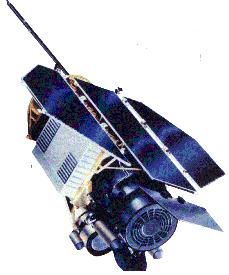
Home - Search - Browse - Alphabetic Index: 0- 1- 2- 3- 4- 5- 6- 7- 8- 9
A- B- C- D- E- F- G- H- I- J- K- L- M- N- O- P- Q- R- S- T- U- V- W- X- Y- Z
ROSAT
 Rosat Credit: NASA |
AKA: ROentgen SATellite. Status: Operational 1990. First Launch: 1990-06-01. Last Launch: 1990-06-01. Number: 1 . Gross mass: 2,426 kg (5,348 lb).
NASA NSSDC Master Catalog Description
The Roentgensatellit (ROSAT) was a joint German, US and British X-ray astrophysics project. ROSAT carried a German-built imaging X-ray Telescope (XRT) with three focal plane instruments: two German Position Sensitive Proportional Counters (PSPC) and the US-supplied High Resolution Imager (HRI). The X-ray mirror assembly was a grazing incidence four-fold nested Wolter I telescope with an 84-cm diameter aperture and 240-cm focal length. The angular resolution was <5 arc-s at half energy width. The XRT assembly was sensitive to X-rays between 0.1-2 keV (10-0.6 nm). In addition, the British-supplied extreme ultraviolet (XUV) telescope, the Wide Field Camera (WFC), was coaligned with the XRT and covered the energy band from 0.042-0.21 keV (30-6 nm).
ROSAT's unique strengths were high spatial resolution, low-background, soft X-ray imaging for the study of the structure of low surface brightness features, and for low-resolution spectroscopy.
The ROSAT spacecraft was a three-axis stablized satellite which could be used for pointed observations, for slewing between targets, and for performing scanning observations on great circles perpendicular to the plane of the ecliptic. ROSAT was capable of fast slews (180 degrees in ~15 min.) which made it possible to observe two targets on opposite hemispheres during each orbit. The pointing accuracy was 1 arc-minute with stability <5 arc-s/s and jitter radius of ~10 arc-s. Two CCD star sensors were used for optical position sensing of guide stars and attitude determination of the spacecraft. The post facto attitude determination accuracy was 6 arc-s.
The ROSAT mission was divided into two phases. After a two-month on-orbit calibration and verification period, an all-sky survey was performed for six months using the PSPC in the focus of XRT, and in two XUV bands using the WFC. The survey was carried out in the scan mode. The second phase consists of the remainder of the mission and was devoted to pointed observations of selected astrophysical sources. In ROSAT's pointed phase, observing time was allocated to Guest Investigators from all three participating countries through peer review of submitted proposals. ROSAT had a design life of 18 months, but was expected to operate beyond its nominal lifetime.
More at: ROSAT.
Family: Astronomy, Medium earth orbit, X-ray astronomy satellite. Country: Germany. Launch Vehicles: Thor, Delta, Delta 2 6000, Delta 6920-10. Launch Sites: Cape Canaveral, Cape Canaveral LC17A. Agency: DLR. Bibliography: 2, 279, 4063, 6, 6831, 13030.
 | ROSAT Credit: Manufacturer Image |
1990 June 1 - . 21:48 GMT - . Launch Site: Cape Canaveral. Launch Complex: Cape Canaveral LC17A. LV Family: Thor. Launch Vehicle: Delta 6920-10.
- ROSAT - . Mass: 2,426 kg (5,348 lb). Nation: Germany. Agency: DLR. Class: Astronomy. Type: X-ray astronomy satellite. Spacecraft: ROSAT. Decay Date: 2011-10-23 . USAF Sat Cat: 20638 . COSPAR: 1990-049A. Apogee: 554 km (344 mi). Perigee: 539 km (334 mi). Inclination: 53.00 deg. Period: 95.60 min. West German extreme UV, X-ray telescope; all-sky survey..
Back to top of page
Home - Search - Browse - Alphabetic Index: 0- 1- 2- 3- 4- 5- 6- 7- 8- 9
A- B- C- D- E- F- G- H- I- J- K- L- M- N- O- P- Q- R- S- T- U- V- W- X- Y- Z
© 1997-2019 Mark Wade - Contact
© / Conditions for Use